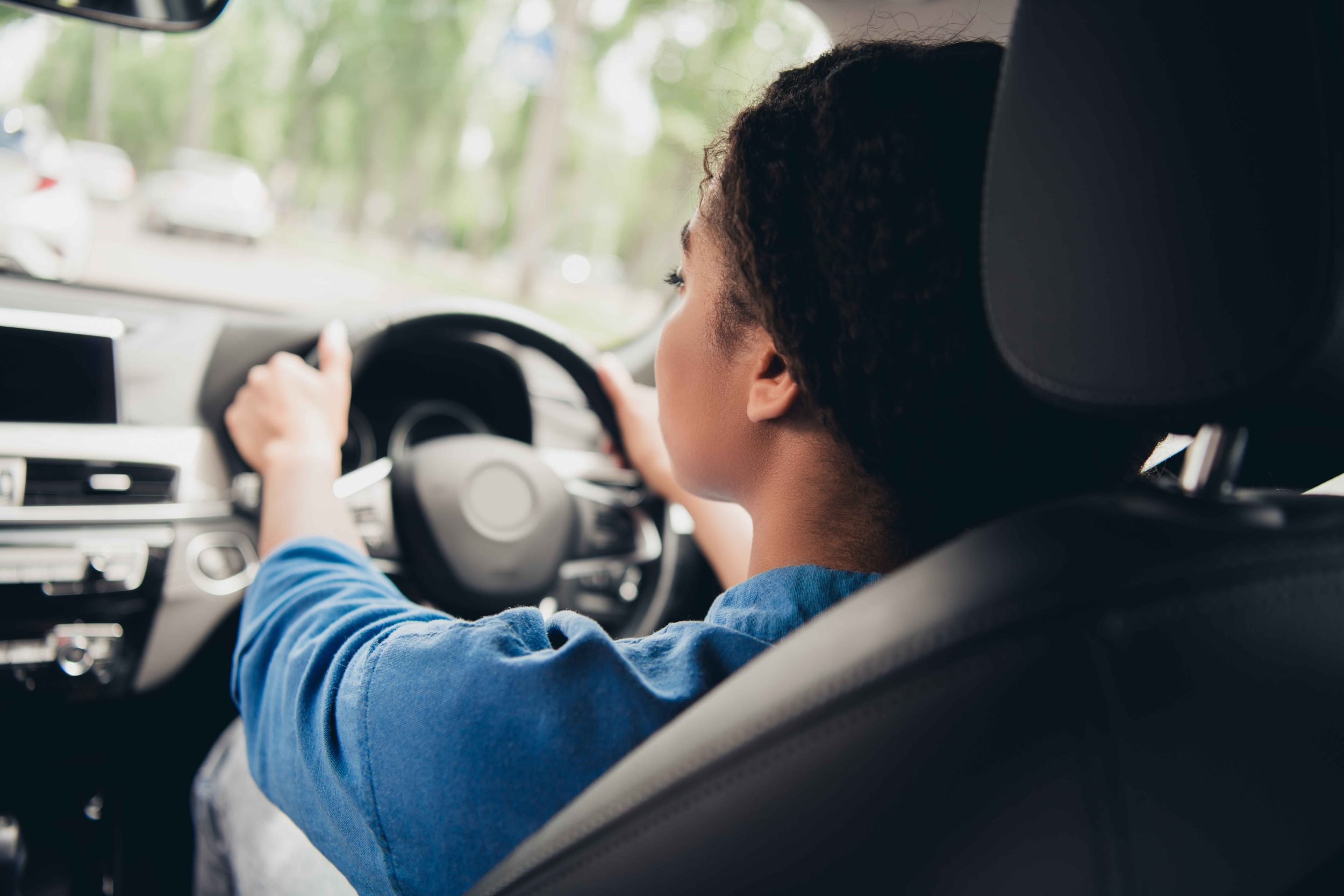Road crossings are an important element of road safety in many urban areas, ensuring safe and easy crossing of busy roads for pedestrians, cyclists and even horse riders. In this blog, we’ll cover the various different types of road crossings in the UK, explaining the differences between them, how to identify them and how best to tackle them as both a driver and a pedestrian.
What is a road crossing?
A road crossing is a designated point along a road where pedestrians, cyclists and other road users can safely cross the road. In the UK, there are several types of road crossings, each designed to ensure safety for different road users when crossing a road.
What is the difference between controlled and uncontrolled crossings?
There are two different types of road crossings in the UK, controlled crossings and uncontrolled crossings.
Controlled road crossings use traffic controls such as stop signs or light signals to manage the flow of vehicles and give priority to pedestrians when needed. These crossings ensure that pedestrians have a dedicated time when traffic is stopped to cross the road safely.
Uncontrolled road crossings do not have traffic signals or signs controlling the crossing. When using one of these types of crossings, pedestrians must wait for a safe gap in traffic to cross the road, making their own judgement about when it is safe to do so.
What are some different types of uncontrolled road crossings?
In the UK, there are two main types of uncontrolled road crossings; these include, zebra crossings and school warden crossings.
Zebra crossing
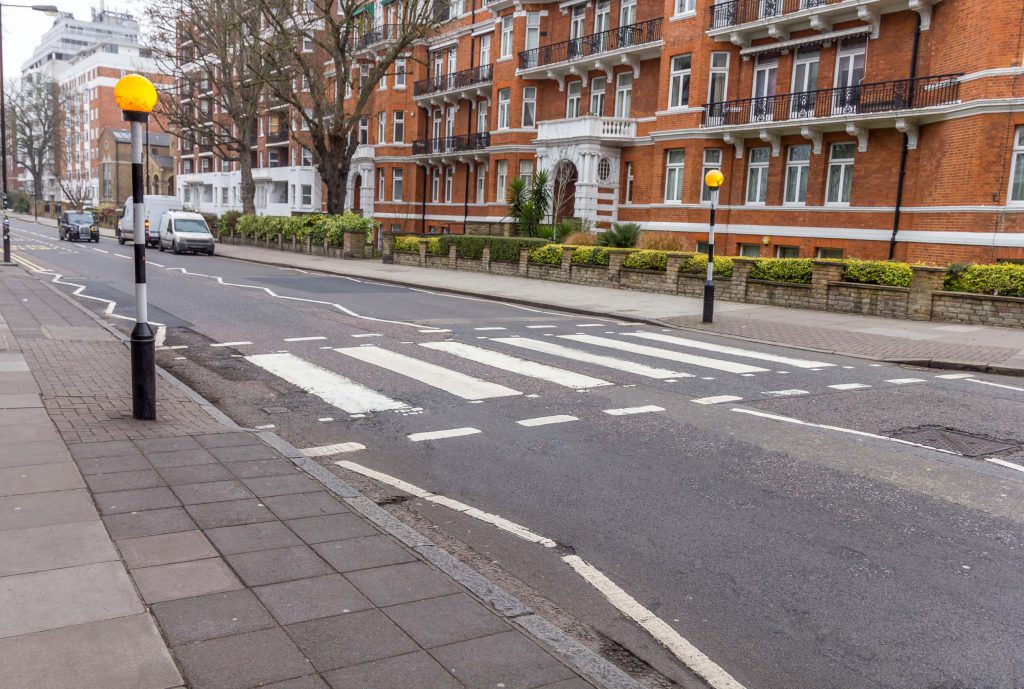
Abbey road crossroad, London, UK
Zebra crossings are marked by black and white stripes painted on the road resembling a zebra’s stripes, as their name suggests. These crossings are typically accompanied by flashing yellow beacons, but not traffic lights.
Drivers are required to stop and give way to pedestrians waiting at the crossing. Pedestrians should ensure that vehicles have stopped before stepping onto the crossing.
School warden crossing
School warden crossings are supervised by school crossing patrols, often seen holding a stop sign to indicate to vehicles that they must come to a stop. These crossings are particularly common near schools and ensure that children are able to cross roads safely.
Drivers must stop when a school warden steps into the road with a stop sign. Pedestrians should wait for the warden’s signal that it is safe to cross the road before they step out onto the crossing.
What are some different types of controlled road crossings?
In the UK, there are various types of controlled road crossings, each catering to different types of pedestrians; these include, pelican crossings, puffin crossings, toucan crossings and equestrian crossings.
Pelican crossing
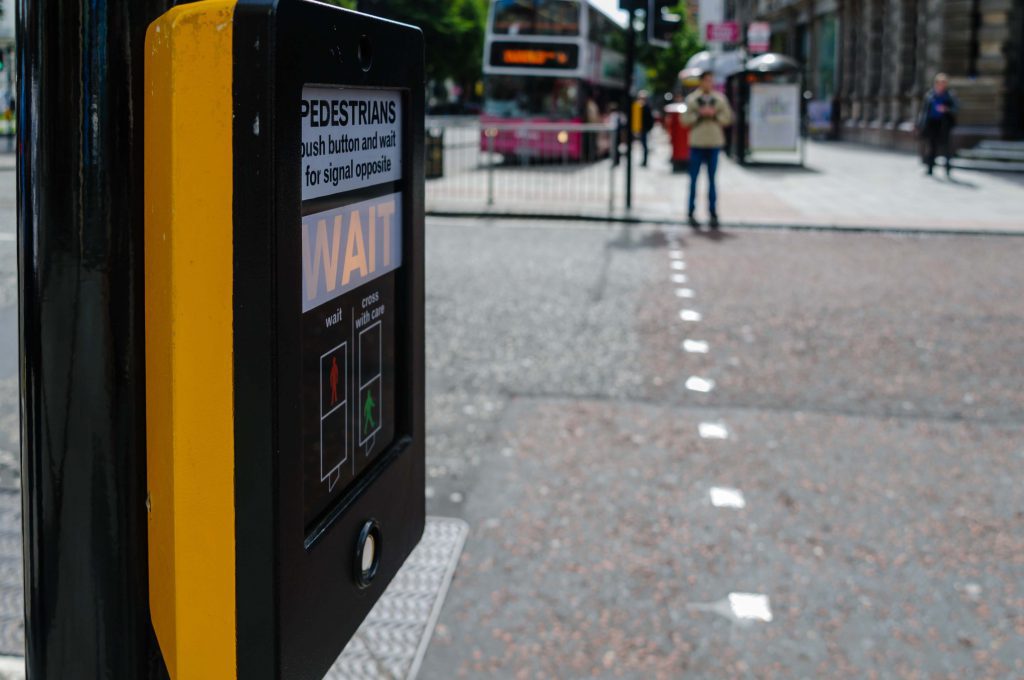
Pelican crossings are one of the most popular types of road crossings. They feature sets of zig-zag lines before and after the crossing on either side of the road and traffic lights that pedestrians can activate by pressing a button. Once the button is pressed, the traffic lights will eventually change, stopping vehicles and allowing pedestrians to cross the road safely.
Pelican crossings often include audible tones and textured paving to assist visually impaired pedestrians so they can also use these crossings to cross the road safely.
Drivers must stop when the traffic lights change to red to allow pedestrians waiting at the crossing to cross the road. Pelican crossings are the only crossings which have a flashing amber light as part of the light sequence. If you see a flashing amber light on the traffic lights at a pelican crossing, stopped traffic must give way to pedestrians already crossing. If the crossing is clear, vehicles may start driving past the crossing. If the light at the crossing is green, drivers do not need to stop.
Pedestrians should wait at the crossing until the traffic lights change to red, and the green man is visible. As a pedestrian, you should ensure that vehicles have stopped before stepping onto the crossing.
Puffin crossing
Puffin crossings have sets of zig-zag lines before and after the crossing on either side of the road and traffic lights that have sensors on.
These crossing look very similar to pelican crossings but differ in that they include sensors that detect when pedestrians have finished crossing the road. This helps to manage traffic flow more efficiently, as the lights will change once the crossing is clear.
Puffin crossings are also fitted with small rotating handles which helps pedestrians with poor sight know when it is safe to begin crossing.
Drivers must stop when the traffic lights change to red to allow pedestrians waiting at the crossing to cross the road. If the light at the crossing is green, drivers do not need to stop.
Pedestrians should wait at the crossing until the traffic lights change to red, and the green man is visible. As a pedestrian, you should ensure that vehicles have stopped before stepping onto the crossing.
Toucan crossing
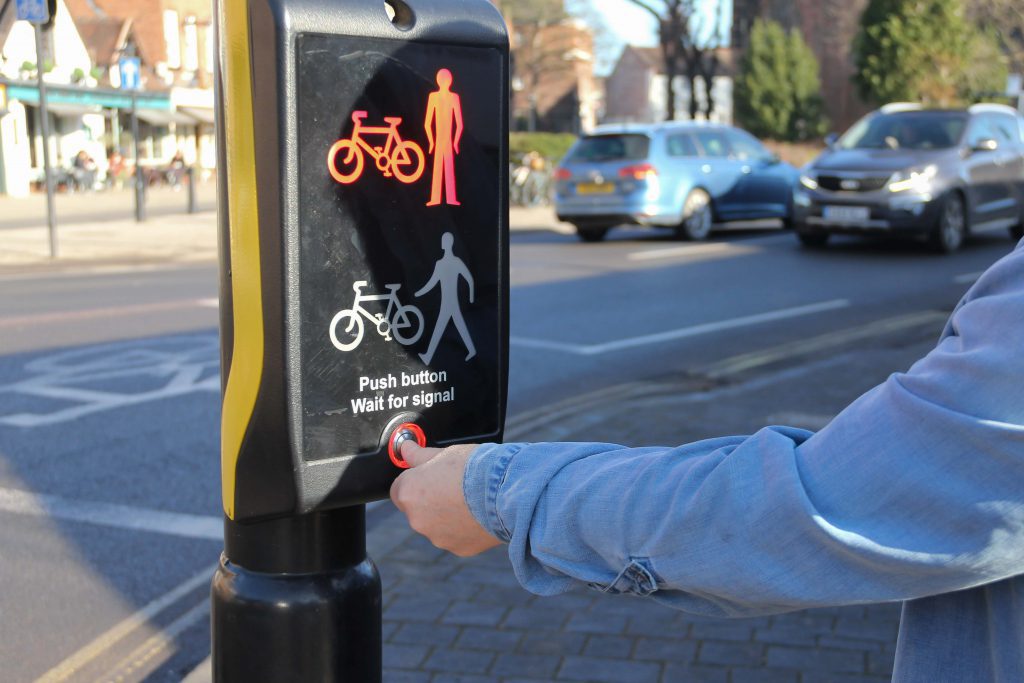
Toucan crossings look very similar to pelican and puffin crossings, the difference being that toucan crossings have additional signals for cyclists and are wider. They are often situated around parks and cycle lanes.
They are designed for both pedestrians and cyclists to use, their primary function being that they allow cyclists to cross roads without having to dismount. They have both a green man signal and a green bike signal to show when it is safe to cross the road.
Drivers must stop when the traffic lights change to red to allow pedestrians and cyclists waiting at the crossing to cross the road. If the light at the crossing is green, drivers do not need to stop.
Pedestrians and cyclists should wait at the crossing until the traffic lights change to red, and the green man or green cyclist is visible. As a pedestrian or cyclist, you should ensure that vehicles have stopped before stepping onto the crossing.
Equestrian crossing
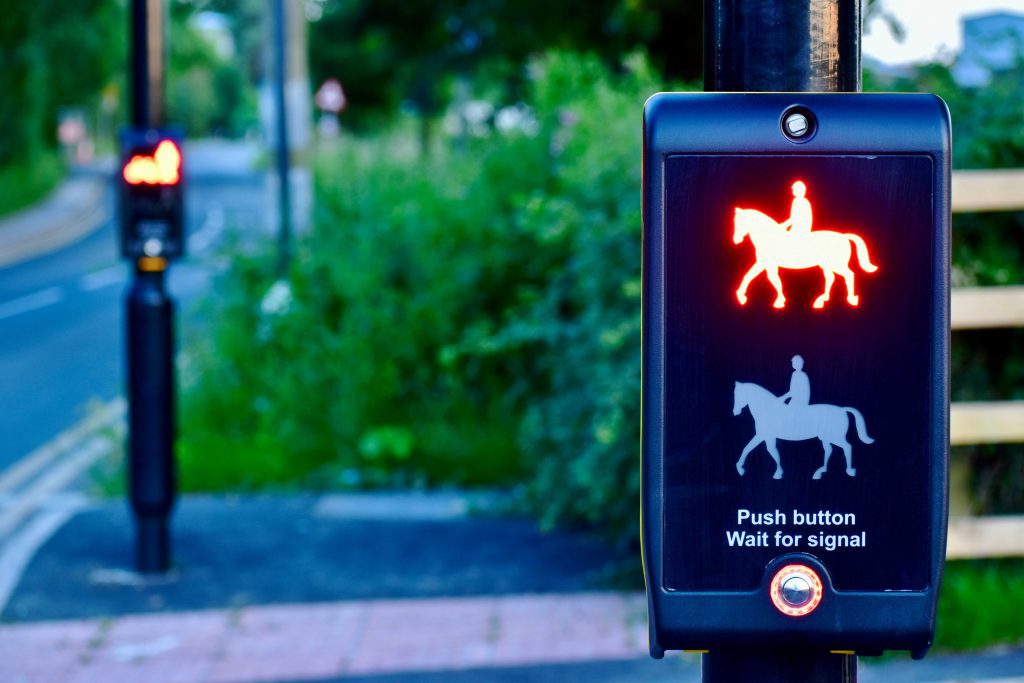
Equestrian, or pegasus crossings, are specifically designed for horse riders, featuring wider crossing areas and higher control buttons so that riders don’t need to dismount to cross the road. They can also be used by pedestrians and have control buttons at a normal height for pedestrians to operate.
They operate in the same way as pedestrian only crossings, and like puffin crossings, they can also detect when there is movement on the road.
Drivers must stop when the traffic lights change to red to allow pedestrians and horse riders waiting at the crossing to cross the road. If the light at the crossing is green, drivers do not need to stop.
Pedestrians and horse riders should wait at the crossing until the traffic lights change to red, and the green man or green horse is visible. As a pedestrian or horse rider, you should ensure that vehicles have stopped before stepping onto the crossing.
How can I spot different types of road crossings?
Different crossings have different identifiers, you should look out for warning triangles, zig-zag road markings, flashing yellow beacons or traffic lights with pedestrian controls. Familiarising yourself with these markers will help you to navigate different types of road crossings safely, both as a driver or pedestrian.
What is best practice when it comes to road crossings?
Pedestrians and drivers use road crossings in different ways and should adopt specific approaches when using crossings.
As a pedestrian
Pedestrians should always use designated crossings where available when crossing the road. At controlled crossings, you should always wait for the green signal before stopping and check that vehicles have come to a stop before stepping out onto the crossing. At uncontrolled crossings, pedestrians should look both ways and ensure that it is safe to cross before stepping onto the crossing, whether that is because the road is clear of traffic or vehicles have come to a stop.
As a driver
Drivers should remain vigilant when driving and look out for road crossings, especially in areas with high pedestrian traffic. Approach crossings with caution and be prepared to stop if you need to. At controlled crossings, you must come to a full, controlled stop when the traffic lights are on red. At uncontrolled crossings, you must come to a full, controlled stop when it is necessary to give way to pedestrians. At any time, you should never block a crossing, even in heavy traffic,
Why are road crossings so important for safety out on the roads?
Road crossings play a vital role in enhancing road safety. They reduce the risk of accidents by providing safe points along a road for pedestrians, cyclists and even horse riders to cross, whilst also helping to manage traffic flow. Statistics show that properly marked and used crossings lower the number of pedestrian accidents on the road.
Will I be tested on the different road crossing when learning how to drive?
Understanding and navigating different types of road crossings is a key part of learning to drive. Driving examiners will expect you to be familiar with and understand the range of road crossings and will assess your ability to identify and properly use these crossings during your practical driving test.
Knowledge of road crossings is also essential for your driving theory test. Questions around road crossings and how to identify them could come up in your test, including how to navigate them as a road user.
Get learner car insurance with Dayinsure
If you’re learning to drive or thinking about getting in some extra practice around lessons, make sure that you’re properly insured. Dayinsure’s short-term learner driver insurance is fully comprehensive, giving you peace of mind whilst out on the roads gaining experience.
Our learner insurance is flexible, with cover available from 1 day up to 5 months. Find out more about our learner driver insurance here and get a quote today.


